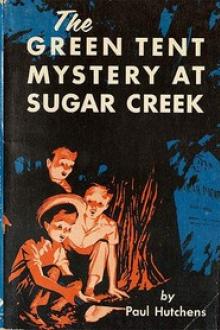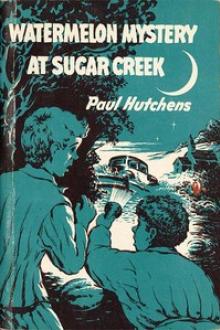The Green Tent Mystery at Sugar Creek by Paul Hutchens (red white and royal blue hardcover txt) 📕

- Author: Paul Hutchens
- Performer: -
Book online «The Green Tent Mystery at Sugar Creek by Paul Hutchens (red white and royal blue hardcover txt) 📕». Author Paul Hutchens
Then I looked over the rail fence into Dragonfly’s pop’s pasture and saw what looked like twenty scared cows racing furiously across the field, their tails up over their backs and also switching fiercely like the cows were terribly excited.
“It’s a stampede!” Dragonfly cried excitedly.
Say, those cows acted like they were blind and deaf and dumb and scared out of what few wits a cow has and were all running wildly to get away from something—only I couldn’t see anything for them to run away from.
“I’ll bet it’s a lot of warble flies after them,” I said, remembering quick what Pop and I had been studying that week while we were looking up June beetles.
“What’s a warble fly?” Little Tom Till wanted to know, his folks not having any cows—and they always got the milk they drank at their house from Dragonfly’s folks or mine.
Well, anybody who knows anything about a warble fly knows that it is a noisy, buzzing fly about half as big as a big, black horse-fly and it only lives six days after it is born.
“A warble fly doesn’t have any mouth and can’t sting or bite a cow or anything,” I said, feeling all of a sudden quite proud of myself that I had learned so much about a lot of important things such as flies and beetles and other insects.
“Then why are cows scared of them?” Poetry asked, even he not knowing that.
“They just make a fierce, buzzing sound and dive in and lay their eggs on the hair of the cows and as fast as the cows run the fly flies just that fast and flits in and out laying eggs on them. Then after six days of that kind of life it dies. It probably starves to death,” I said, “not being able to eat.”
“And cows are scared of an innocent egg?” Circus asked, and just then got a little scared himself as did all of us because those twenty milk cows were making a beeline for our fence. “They’re coming for the shade,” I said. “Warble flies don’t like shade.”
And I was right, for a jiffy later in a cloud of whirling dust those twenty cows came to an excited halt under the maple tree just over the fence from us—only they didn’t stay stopped but kept milling around, stamping their forty front feet and switching their twenty tails madly, also doing the same kind of stamping with their forty back feet. It seemed like there were a lot of warble flies and I saw and heard some of them diving in and out under the cows, which kept on switching their tails fiercely and stamping their feet, which meant that if a boy had been there trying to milk one of them, he would have gotten the living daylights kicked out of him and his pail of milk spilled all over the ground or all over his clothes—and his parents would wonder what on earth if they saw him like that.
So not getting any peace, those excited cows, still pestered with the flies, started on another stampede and this time it was towards the bayou and I knew that if they came to the weak place in the rail fence, where we sometimes climbed over, they would make a dive through it and rush into the brush and through the bushes and down the hill and in a jiffy would be in one of the sluggish ends of the bayou in the shade, which flies don’t like. If the cows would stand up to their sides in the shady water, the warble flies would leave them alone on account of warble flies always lay their eggs on the legs and under parts of a cow.
“Hey!” Dragonfly exclaimed excitedly, being as worried as his pop probably would have been. “They’re going straight for the bayou!”
I knew if they did break through that fence and get into the water, they could also wade across and get into the cornfield on the other side and they might eat themselves to death like cows sometimes do.
Dragonfly grabbed up a stick and started out after the cows as fast as his spindling legs could carry him, which wasn’t too fast. Circus who was faster, was already dashing fiercely down the other side of the fence to get to the place which the cows were headed for.
I was running as fast as I could, following the gang—some of the gang following me—when I stepped into a brand new ground-hog den, which I had never seen before, and down I went kerplop onto the ground. I was certainly surprised ’cause there hadn’t been any hole there before. I knew every ground-hog den there was for a mile in every direction from our house.
Then I noticed the hole wasn’t a ground-hog den at all but was another kind of hole. You could tell it hadn’t been dug by any live, heavy-bodied, short-tailed, blunt-nosed, short-haired, short-legged, coarse-haired, grizzly-brown animal with four toes and a stubby thumb on its two front feet and five toes on its two hind feet—which is what a ground-hog is. Besides there wasn’t any ground-hog odor coming out of the hole, which my freckled nose was very close to right that second—and also besides, there were the marks of a shovel and a woman’s high-heeled shoes in the freshly dug soil.
I COULDN’T let myself stay there on the ground all sprawled out in five different directions wondering what had happened to me, because the gang had already gone and left me, running as fast as they could to catch up with and head off Dragonfly’s pop’s cows to keep them from breaking through the fence into the bayou, so I unscrambled myself, rolled over and up onto my feet and in a jiffy was helping the gang by running and yelling and screaming to the cows to obey us—which they didn’t.
Even as I ran, I was remembering what Pop and I had learned about warble flies—or heel flies, as some folks call them—and I thought what if I was a real cow instead of merely being as awkward as one part of the time? If I had my own brain with what it knew about warble flies, I would have the living daylights scared out of me, my cow-self, on account of even though a warble fly doesn’t have any mouth and never eats any food during the six days of its short life, it does lay eggs all over the legs and lower part of the cow.
When a warble fly egg hatches, which it does in four or five days after it is laid, the thing that hatches out isn’t a fly at all but is a grub, which quick starts to bore its grubby way right through the cow’s skin and into the cow. Once it gets inside, the dumb thing starts on a chewing journey through the inside, making its own path as it goes and making the cow itch like everything, which is maybe why some cows are not as friendly as other cows at certain times of the year. I’ll bet if I were a cow, I wouldn’t be worth a whoop to a farmer or anybody who owned me because I would probably feel the grub and maybe a half-dozen or more of his grubby relatives working their way all through me, some of them stopping like grubs do, right in my throat and staying a while just above where I would be chewing my cud.
During the whole five or six months while a grub is still inside of a cow, it travels all around and finally chews a tunnel along the edges of the cow’s spinal column and at last it stops and makes its home right under the skin of the back. There it chews a small hole all the way through the cowhide so it can breathe, which it does with its tail, getting good fresh country air through the hole, staying there nearly through the winter.
While still there, the grub develops into a wiggling, twisting, squirming warble and finally works its way out through the air hole and tumbles off to the ground, and if it is spring and it doesn’t get eaten up by a cowbird or a grackle or some other bird, it gets hard and black and finally changes into a fly on the inside of itself. Then as quick as it is a fly, it crawls out of itself and makes a dive for the first cow it can find, starting to lay eggs as fast as it can before its six short days of noisy, buzzing fly-life are over.
I was remembering all that as I galloped along after Dragonfly’s pop’s stampeding cows. I was also remembering that in the wintertime in some parts of America, starlings, and even magpies light on the backs of cows and start pecking away on them, trying to dig out the warbles with their sharp bills.
Boy, oh boy, if I was a cow and one or a half-dozen of those very high-voiced, buzzing flies was trying to lay her eggs on me and I knew what would happen if they did, I would most certainly beat it for the shade, which warble flies don’t like. Or if I could, I would find somebody’s bayou or a little stream somewhere, splash myself out into it and stand in the water up to my sides like I had seen cows do all around Sugar Creek for years without knowing before why they did it.
Say, you should have seen Dragonfly’s pop’s cows ignore the few rails on the fence when they got to it. They broke right through without stopping and disappeared in a tail-swishing hurry into the brush. By the time we got to the fence ourselves, those cows were down in the sluggish water of the pond at the east end of the bayou.
Maybe I’d better tell you that Pop says that every year American meat packers throw away enough grubby meat to feed eighty-three thousand people for a whole year—all on account of the crazy warble flies. Also, Pop says, a lot of cows’ hides have holes in them when they are butchered and people lose money that way too on account of that part of the cow is where the leather is generally best—and what good is a piece of leather for making shoes or leather goods if it has a hole in it? So a boy ought never to drive a bunch of cows out of a creek or a pond on a hot summer day, but should let them stay there in the shade if they want to.
Cows don’t give as much milk while they are worrying about noisy, whining flies, either, and beef cattle don’t get fat as fast, it not being easy to get fat if you worry a lot, which is maybe why some people are too thin.
Anyway that is how come we didn’t get to look for the tent of the “turtledove” and the “bobwhite” until quite a while later. It took us almost an





Comments (0)